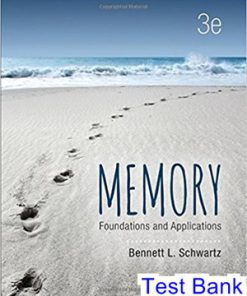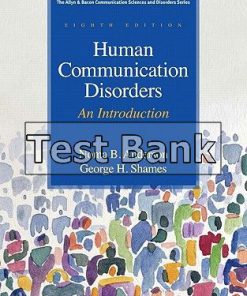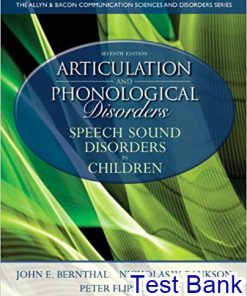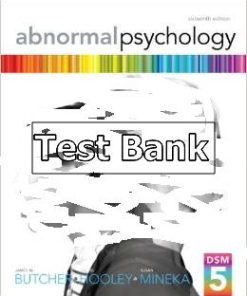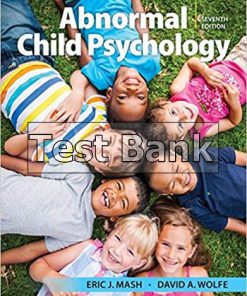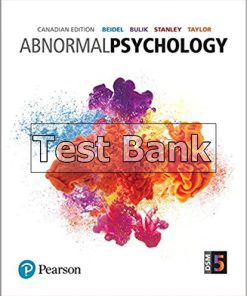Primer on Communication and Communicative Disorders 1st Edition SchWartz Test Bank
$26.50$50.00 (-47%)
Primer on Communication and Communicative Disorders 1st Edition SchWartz Test Bank.
You may also like
Primer on Communication and Communicative Disorders 1st Edition SchWartz Test Bank
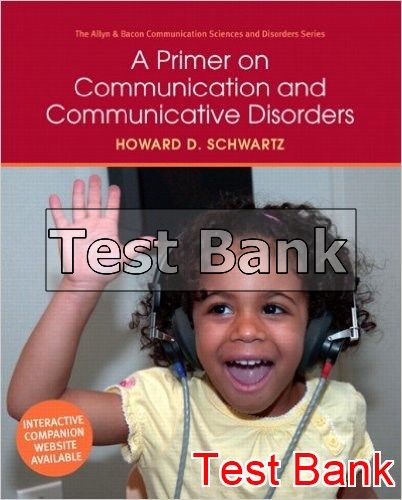
Product details:
- ISBN-10 : 0205496369
- ISBN-13 : 978-0205496365
- Author: Dr. Howard D. Schwartz
An easy-to-read introduction to communication sciences and disorders appropriate for majors and non-majors alike.
This text is written by an expert in the field who has taught introductory communicative disorders courses to both majors and non-majors for numerous years. This first edition presents information comprehensively and uses an easy to read, enthusiastic tone of voice that encourages students to explore the content covered in greater detail beyond the text itself. Introducing the basic concepts and methods related to studying communication, the text covers both typical speech and language development along with information on disordered speech and language. Throughout A Primer on Communication and Communicative Disorders, students are assisted by valuable study aids and features that help them learn vital terms, process information, check their knowledge, and apply what they have read to real clinic situations and issues. This introductory text is particularly unique in its coverage of important topics such as swallowing disorders and multicultural issues in speech and communication.
Table contents:
Chapter 1: Communication and Communicative Disorders
Communication
Communicative Disorders
Examples of Communicative Disorders
Professionals Who Work With Disordered Communication
Speech-Language Pathologists
Training, Certification and Licensure
Employment
Audiologist
Training, Certification and Licensure
Employment
Professional Organizations
American Speech-Language Hearing Association
Additional Professional Organizations
Summary and Review
Websites of Interest
Chapter 2: Anatomy and Physiology of Speech, Language and Voice Production
Central Nervous System
Brain
Spinal Cord
Peripheral Nervous System
Cranial Nerves
Autonomic Nervous System
Anatomy and Physiology of Speech Production
Respiratory System
Anatomy of Breathing
Physiology of Breathing
Laryngeal/Phonatory System
Anatomy of Sound Production
Physiology of Sound Production
Articulatory System
Anatomy and Physiology of Shaping Sounds
Summary and Review
Websites of Interest
Chapter 3: Speech Sounds, Articulation and Phonological Disorders
Language and Speech
Sounds in English
Classification of Speech Sounds
Vowels
Consonants
Place of Articulation
Manner of Production
Voicing
Speech Sound Development during the First Year of Life
Newborns
2-3 Months
4-6 Months
7-10 Months
11-12 Months
Speech Sound Developmental Milestones
Disorders of Articulation
Traditional Methods of Classifying Speech Sound Errors
Substitutions
Omissions
Distortions
Additions
Disorders of Phonology
Syllable Structure Processes
Final Consonant Deletion
Reduplication
Consonant Cluster Simplification
Segment Change or Substitution Processes
Stopping
Articulation and Phonological Disorders Associated With Physical Differences
Cleft Lip and Palate
Dysarthria
Apraxia of Speech
Hearing Loss
Assessment of Articulation and Phonological Disorders
Phonology/Speech Articulation Screening
Hearing Screening
Oral-Facial Examination
Speech Sound Inventory
Conversational Speech Sampling
Error Pattern Analysis
Stimulability
Assessing Speech in Context
What Do I Do With All Of This Information?
Articulation Therapy
Linguistic/Phonological Based Therapy
Summary and Review
Websites of Interest
Chapter 4: Language Development in Children
Bernard Grela, Ph.D.
University of Connecticut
Modes of Communication
Components of Language
Theories of Language Acquisition: Nature versus Nurture
Periods of Language Development
Prelinguistic Communication
Semantics
Perception
Pragmatics
First Words
Semantics
Pragmatics
Preliteracy
Early Language Development
Semantics
Syntax and Morphology
Pragmatics
Preliteracy
Preschool Language
Semantics
Syntax and Morphology
Pragmatics
Narratives
Preliteracy Skills
The School Years
Literacy
Semantics
Syntax and Morphology
Pragmatics
Narratives
Summary and Review
Websites of Interest
Chapter 5 Language Disorders in Children
Nina C. Capone
Seton Hall University
The Domains of Language
Form
Content
Use
Receptive Language versus Expressive Language
Language Difference is Not a Language Disorder
Defining Language Disorders in Children
Characterizing Language Impairments
Form
Content
Use
Evaluation of Children with Language Impairments
Types of Language Impaired Populations
Late Talkers
Specific Language Impairment
Autism Spectrum Disorders
Down Syndrome
Children At-Risk for Language Impairments
Intervention
Summary and Review
Website of Interest
Chapter 6 Communication in a Multicultural Society
Amy L. Weiss, Ph.D
University of Rhode Island
What is a Culture?
Why Is Cultural Competence Important?
Culture and the Changing Face of the Population
The Characteristics of Culture
Roles
Caregivers
Professionals
The Role of Communication within the Culture
Verbal and Non Verbal Communication
The Role of Communicative Disorders within the Culture
Speech and Language Differences versus Disorders
Definitions
Examples of American Speech Dialects
Examples of Dialect Differences
Assessment of Speech and Language with Cultural Awareness
Treatment of Speech and Language Differences
Treatment of Bona Fide Speech and Language Disorders in an L1 Other than English
Summary and Review
Website References
Chapter 7: Neurological Impairment: Speech and Language Disorders in Adults
Brain Anatomy Associated with Speech and Language Disorders
Language Disorders Associated with Neurological Impairment
Deficits of Expressive Language
Deficits of Comprehension
Deficits in Reading and Writing
Aphasia Classification
Broca’s Aphasia
Wernicke’s Aphasia
Global Aphasia
Anomic Aphasia
Assessment of Language Disorders Associated With Neurological Impairment
Treatment of Language Disorders Associated With Neurological Impairment
Right Hemisphere Damage and Communicative Disorders
Traumatic Brain Injury
Dementia
Motor Speech Disorders
Dysarthria
Apraxia
Treatment of Motor Speech Disorders
Summary and Review
Website References
Chapter 8: Voice Disorders
Anatomy of Voice Production
Characteristics of Voice Production
Definitions and Prevalence of Voice Disorders
Classifying Voice Disorders
Phonotrauma
Phonotrauma and Changes in Laryngeal Tissue
Traumatic Laryngitis
Vocal Nodules
Vocal Polyps
Voice Problems and Neurological Disorders
Vocal Fold Paralysis
Spasmodic Dysphonia
Organic Disease
Granulomas
Papilloma
Carcinoma (Cancer)
Assessment of Voice Disorders
Interviewing the Client
Viewing the Larynx
Indirect Laryngoscopy
Direct Laryngoscopy
Acoustic and Physiological Measures of Voice
Treating Voice Disorders
Phonotrauma
Alaryngeal Communication
Summary and Review
Website References
Chapter 9: Swallowing Disorders
Cynthia D. Hildner M.S.
Northern Illinois University
Anatomy and Physiology of Swallowing
Phases of Normal Swallowing
Oral Preparatory Phase
Oral Phase
Pharyngeal Phase
Esophageal Phase
Disordered Swallowing
Swallowing Phases and Dysphagia
Swallowing Disorders Associated With Various Organic Conditions
Cerebrovascular Accidents
Traumatic Brain Injury
Amyotrophic Lateral Sclerosis (ALS)
Parkinson’s disease
Head and Neck Cancers
The Multidisciplinary Dysphagia Team
Evaluating Swallowing
Screening Swallowing
Clinical Assessment of Swallowing
Instrumental Evaluations of Swallowing
Videofluoroscopic Swallow Study (VFSS)
Fiberoptic Endoscopic Evaluation of Swallowing (FEES)
Dysphagia Treatment
Swallowing Compensations
Posures
Swallowing Maneuvers
Diet Modifications
Swallowing Exercises
Education and Training
Non-Oral Feeding Considerations
Variations in Swallowing Across the Lifespan
Summary and Review
Website References
Chapter 10: Fluency Disorders
Fluency and Stuttering
The Onset of Stuttering
Incidence and Prevalence
Genetics and Stuttering
Onset: Gradual or Sudden
The Development of Stuttering
Theories Regarding the Causes Of Stuttering
Organic Theories
Behavioral Theories
Linguistic Theories
Biology Plus Environment
Evaluating Stuttering
Treating Adults Who Stutter
Treating Children Who Stutter
Other Fluency Disorders
Summary and Review
Websites of Interest
Chapter 11: Anatomy and Physiology of Hearing, Hearing Disorders
The Transmission of Sound
Sound
Frequency and Pitch
Intensity and Loudness
Ear Anatomy and Physiology
Outer Ear
Middle Ear
Inner Ear
Disorders of Hearing
Conductive Hearing Loss
Sensorineural Hearing Loss
Congenital Sensorineural Hearing Loss
Acquired Sensorineural Hearing Loss
Mixed Hearing Loss
Summary and Review
Websites of Interest
Chapter 12: Hearing Testing and Management of Hearing Disorders
Hearing Testing
Audiometers
Air Conduction Audiometry
Bone Conduction
Speech Audiometry
Acoustic Immittance
Otoacoustic Emissions
Auditory Evoked Potentials
Hearing Testing Summary
Hearing Testing Result and Definitions
Habilitation/Rehabilitation
Amplification
Hearing Aids
FM Systems and Assistive Listening Devices
Cochlear Implants
Auditory Training
Communication Training
Oral Communication
Manual Communication
Total Communication
Acoustics in the Classroom
Signal-to-noise Ratio
Reverberation
What Can Be Done?
Summary and Review
Websites of Interest
Appendix A
Vocabulary Crossword Puzzles
Chapters 2-12
People also search:
primer on communication studies
a primer on communication studies (v. 1.0)
introduction to communicative disorders 5th edition
a primer on communication studies pdf
a primer on communication studies pdf free



